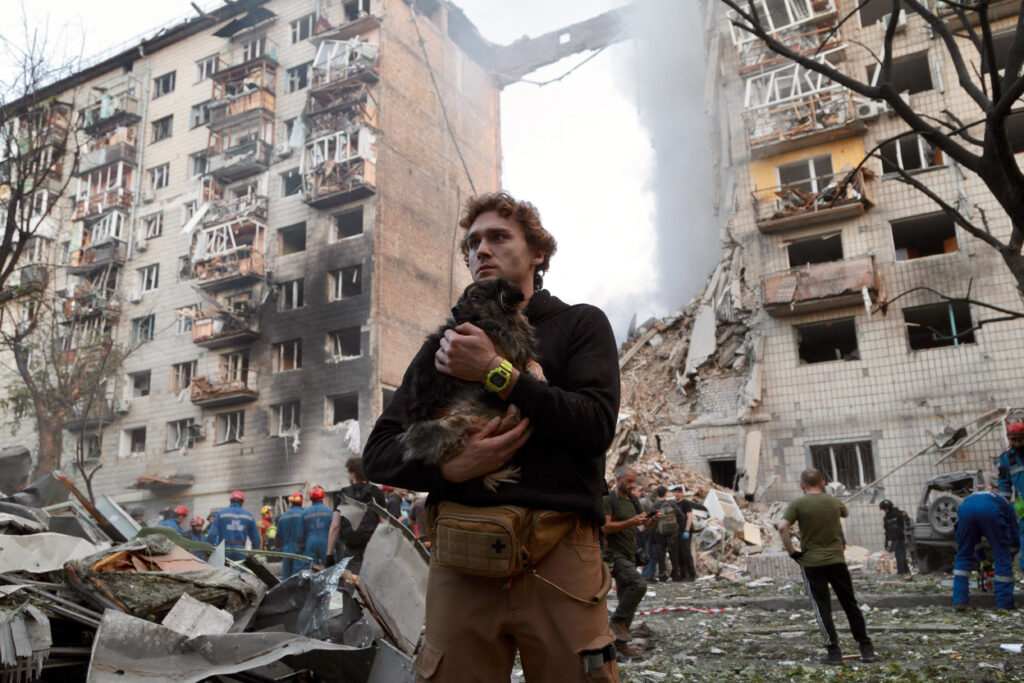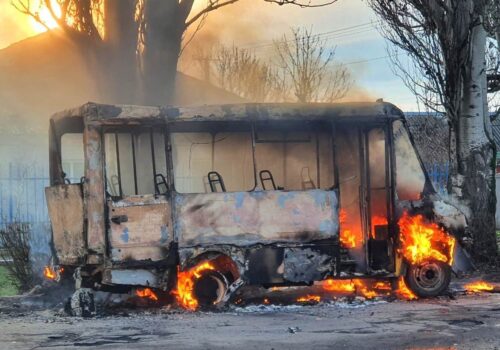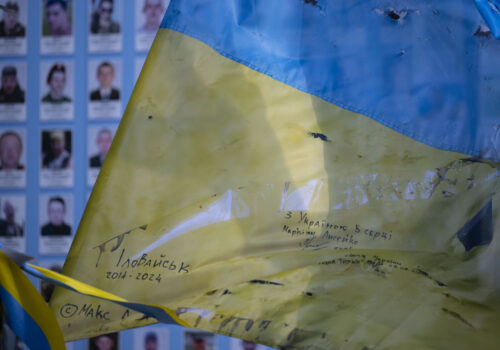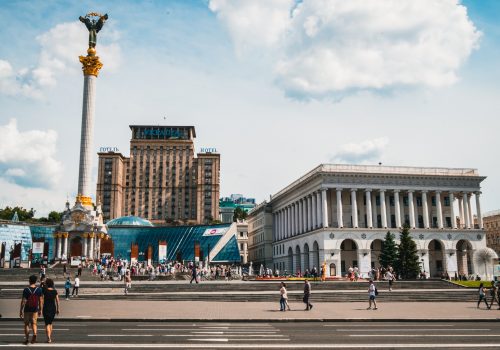As G7 leaders attended a summit in Canada on Monday, Russia unleashed one of the largest bombardments of the Ukrainian capital since the start of Moscow’s invasion more than three years ago. The overnight Russian attack on Kyiv involved hundreds of drones and missiles targeting residential districts across the city. Dozens of Ukrainian civilians were killed with many more injured.
While this latest Kyiv blitz was by no means unprecedented in a war that has been marked by frequent Russian attacks on Ukraine’s civilian population, the timing is unlikely to have been coincidental. Like a mafia boss ordering elaborate killings to send coded messages, Putin has repeatedly scheduled major bombardments of Ukraine to coincide with international summits and gatherings of Western leaders. For example, Russia bombed Kyiv, Odesa, and other Ukrainian cities on the eve of NATO’s 2023 summit, and conducted a targeted missile strike on Ukraine’s biggest children’s hospital as NATO leaders prepared to meet in Washington DC last summer.
Bombing raids have also taken place during high-profile visits of international dignitaries. In spring 2022, Russia launched an airstrike on Kyiv while UN Secretary General António Guterres was in the Ukrainian capital. At the time, Ukrainian President Volodymyr Zelenskyy said the attack was a deliberate attempt by the Kremlin to “humiliate” the United Nations. Two years later, Russia subjected Ukrainian Black Sea port Odesa to intense bombardment as Greek PM Kyriakos Mitsotakis visited the city.
The massive bombardment of Kyiv and other Ukrainian cities during this week’s G7 summit is the latest example of Putin’s penchant for sending messages with missiles. On this occasion his message could hardly have been clearer: Russia does not want peace. On the contrary, Moscow feels increasingly emboldened by growing signs of Western weakness and is more confident than ever of securing victory in Ukraine.
Stay updated
As the world watches the Russian invasion of Ukraine unfold, UkraineAlert delivers the best Atlantic Council expert insight and analysis on Ukraine twice a week directly to your inbox.
Russia’s rejection of US-led peace efforts is equally evident in the diplomatic arena. While Ukraine agreed to US President Donald Trump’s call for an unconditional ceasefire more than three months ago, Russia still refuses to follow suit. Instead, the Kremlin has engaged in obvious stalling tactics while creating a series of obstacles aimed at derailing any meaningful progress toward peace. At one point, Putin even claimed the Ukrainian authorities lacked the legitimacy to negotiate a settlement and suggested the country be placed under temporary UN administration.
The recent resumption of bilateral talks between Moscow and Kyiv has provided further confirmation of Russia’s commitment to continuing the war. Putin personally initiated these talks but then chose not to attend and sent a low-level delegation instead. In the two meetings that have since taken place, Russian officials have presented a list of ceasefire conditions that read like a call for Kyiv’s complete capitulation.
The Kremlin’s demands include Ukraine’s withdrawal from four partially occupied Ukrainian regions that the Russian army has so far been unable to fully occupy. This would mean handing over dozens and towns and cities while condemning millions of Ukrainians to the horrors of indefinite Russian occupation.
Moscow also wants to ban Ukraine from any international alliances or bilateral security partnerships, while imposing strict limits on the size of the Ukrainian army and the categories of weapons the country is allowed to possess. In recent days, Russia’s Deputy Foreign Minister Alexander Grushko has underlined Moscow’s insistence on Ukraine’s total disarmament by calling on the country to destroy all Western weaponry provided since 2022.
Putin’s punitive peace terms are not limited to sweeping territorial concessions and harsh military restrictions. The Kremlin also expects Ukraine to grant the Russian language official status, reinstate the Russian Orthodox Church’s legal privileges, rewrite Ukrainian history in line with Russian imperial propaganda, and ban any Ukrainian political parties that Moscow deems to be “nationalist.”
The Kremlin’s negotiating position envisions a postwar Ukraine that is partitioned, disarmed, internationally isolated, and heavily russified. If imposed, these terms would allow Russia to reestablish its dominance over Ukraine and would deal a fatal blow to Ukrainian statehood. In other words, Putin wants a Ukraine without Ukrainians.
Eurasia Center events

Donald Trump’s talk of peace through strength succeeded in generating considerable optimism during the early months of 2025, but it is now time to acknowledge that this was largely based on wishful thinking. Since Trump returned to the White House, the Russians have significantly escalated their air war against Ukraine’s civilian population. On the battlefield, Putin’s troops are now engaged in the early stages of what promises to be a major summer offensive. Meanwhile, Kremlin officials continue make maximalist demands at the negotiating table that no Ukrainian government could accept. These are not the actions of a country seeking a pathway to peace.
In both words and deeds, Putin is sending unambiguous signals that he has no interest whatsoever in ending his invasion and remains determined to achieve the complete subjugation of Ukraine. This uncompromising stance will not change unless Western leaders can convince Putin that the most likely alternative to a negotiated peace is not an historic Russian triumph but a disastrous Russian defeat.
The steps needed to bring about this change and create the conditions to end the war are no secret. Sanctions measures against Russia must be tightened and expanded to starve the Kremlin war machine of funding and weaken the domestic foundations of Putin’s regime. Countries that currently help Moscow bypass international sanctions must be targeted with far greater vigor. In parallel, Western military aid to Ukraine must be dramatically increased, with an emphasis on providing long-range weapons and financing Ukraine’s rapidly growing domestic defense industry.
All this will require a degree of political will that is currently lacking. It would also be expensive. Indeed, during this week’s G7 summit, Trump balked at the idea of imposing new sanctions, saying they would “cost us a lot of money.” This is dangerously shortsighted. Trump and other G7 leaders need to urgently recognize that if Putin is allowed to succeed in Ukraine, the cost of stopping him will skyrocket.
Peter Dickinson is editor of the Atlantic Council’s UkraineAlert service.
Further reading
The views expressed in UkraineAlert are solely those of the authors and do not necessarily reflect the views of the Atlantic Council, its staff, or its supporters.

The Eurasia Center’s mission is to enhance transatlantic cooperation in promoting stability, democratic values, and prosperity in Eurasia, from Eastern Europe and Turkey in the West to the Caucasus, Russia, and Central Asia in the East.
Follow us on social media
and support our work
Image: A man holds his dog in front of a bomb-damaged residential building in the Solomianskyi district, where a Russian missile strike caused a section to collapse, Kyiv, Ukraine, on June 17, 202. (Photo by Kyrylo Chubotin/Ukrinform/ABACAPRESS.COM)





